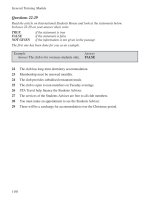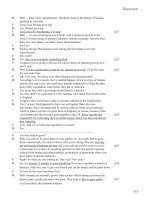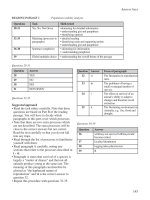Cambridge Practice Tests for IELTS part 8
Bạn đang xem bản rút gọn của tài liệu. Xem và tải ngay bản đầy đủ của tài liệu tại đây (216.76 KB, 15 trang )
100
Questions 22-29
Read the article on International Students House and look at the statements below.
In boxes 22-29 on your answer sheet write
TRUE if the statement is true
FALSE if the statement is false
NOT GIVEN if the information is not given in the passage
The first one has been done for you as an example.
22 The club has long-term dormitory accommodation.
23 Membership must be renewed monthly.
24 The club provides subsidised restaurant meals.
25 The club is open to non-members on Tuesday evenings.
26 STA Travel help finance the Students Adviser.
27 The services of the Students Adviser are free to all club members.
28 You must make an appointment to see the Students Adviser.
29 There will be a surcharge for accommodation over the Christmas period.
General Training Module
Example Answer
Answer The club is for overseas students only. FALSE
101
INTERNATIONAL
STUDENTS
HOUSE
International Students House is a
unique club and accommodation
centre for British and overseas
students in London. It is located in the
heart of London’s West End and is
close to all public transport facilities.
ACCOMMODATION
* comfortable accommodation for up
to 450 people in single, twin, 3/4
bedded and multibedded rooms
* 44 selfcontained flats for married
students and families
* long and short stays welcomed
MEMBERSHIP
Club membership is open to all full
time students, professional trainees,
student nurses and au pairs.
Membership costs are kept to an
absolute minimum to enable the
widest possible access. You can join
for as little as one month and for up to
one year at a time. Membership
entitles you to use the various facilities
of the House. It has:
* restaurants
* student bars and coffee shop
* study rooms
* clubs and societies
* aerobics and fitness training
* discos, dance, jazz and cinema
* travel and excursions and much
more! The best way to check out all
we have on offer is to drop in any
Tuesday evening between 7.15 pm
and 8.30 pm for Open House in the
Club Room. This is an opportunity for
you to meet the staff and other club
members, enjoy a free cup of coffee
and find out all about what’s going
on. You can take advantage of
special membership offers. (Useful
tip: bring along 3 passport size
photographs if you wish to take out
membership.)
ADVICE SERVICE
Thanks to the support of STA Travel
and in association with LCOS (the
London Conference on Overseas
Students) International Students
House now provides the service of an
International Students Adviser. This
new welfare service is open to all
students at London’s bonafide
academic institutions. It aims to
provide welfare support to help
students overcome any personal or
practical difficulties they may be
experiencing whilst studying in
Britain. One of the key features of the
Advice Service is that the Adviser can
be seen during the evenings until
about 8 pm, Monday to Thursday.
CHRISTMAS & NEW YEAR
Unable to get home for Christmas?
How about joining in the fun at
International Students House! Check
out our special programme of activity
taking place over the Christmas
period. Even come and stay the
House will be offering reduced
accommodation rates for students
wishing to spend a few days in
London over Christmas. We’ll also
have an exciting New Year’s Eve
party so come and join us and ring in
the new year in the spirit of
internationalism.
Part Two
102
PART THREE
General Training Module
READING PASSAGE 3
You should spend about 20 minutes on Questions 30-41 which are based on the Reading
Passage below.
PAPER RECYCLING
A
Paper is different from other waste
produce because it comes from a
sustainable resource: trees. Unlike the
minerals and oil used to make plastics
and metals, trees are replaceable.
Paper is also biodegradable, so it
does not pose as much threat to the
environment when it is discarded.
While 45 out of every 100 tonnes of
wood fibre used to make paper in
Australia comes from waste paper, the
rest comes directly from virgin fibre
from forests and plantations. By world
standards this is a good performance
since the world-wide average is 33 per
cent waste paper. Governments have
encouraged waste paper collection
and sorting schemes and at the same
time, the paper industry has re-
sponded by developing new recycling
technologies that have paved the way
for even greater utilisation of used
fibre. As a result, industry’s use of
recycled fibres is expected to increase
at twice the rate of virgin fibre over the
coming years.
B
Already, waste paper constitutes 70%
of paper used for packaging and
advances in the technology required
to remove ink from the paper have
allowed a higher recycled content in
newsprint and writing paper. To
achieve the benefits of
recycling, the community must also
contribute. We need to accept a
change in the quality of paper prod-
ucts; for example stationery may be
less white and of a rougher texture.
There also needs to be support from
the community for waste paper collec-
tion programs. Not only do we need to
make the paper available to collectors
but it also needs to be separated into
different types and sorted from con-
taminants such as staples, paperclips,
string and other miscellaneous items.
C
There are technical limitations to the
amount of paper which can be recycled
and some paper products cannot be
collected for re-use. These include
paper in the form of books and perma-
nent records, photographic paper and
paper which is badly contaminated.
The four most common sources of
paper for recycling are factories and
retail stores which gather large
amounts of packaging material in
which goods are delivered, also offices
which have unwanted business docu-
ments and computer output, paper
converters and printers and lastly
households which discard newspapers
and packaging material. The paper
manufacturer pays a price for the
paper and may also incur the collection
cost.
103
D Once collected, the paper has to be
sorted by hand by people trained to
recognise various types of paper. This
is necessary because some types of
paper can only be made from particular
kinds of recycled fibre. The sorted
paper then has to be repulped or mixed
with water and broken down into its
individual fibres. This mixture is called
stock and may contain a wide variety of
contaminating materials, particularly if it
is made from mixed waste paper which
has had little sorting. Various machin-
ery is used to remove other materials
from the stock. After passing through
the repulping process, the fibres from
printed waste paper are grey in colour
because the printing ink has soaked
into the individual fibres. This recycled
material can only be used in products
where the grey colour does not matter,
such as cardboard boxes but if the grey
colour is not acceptable, the fibres
must be de-inked. This involves adding
chemicals such as caustic soda or
other alkalis, soaps and detergents,
water-hardening agents such as cal-
cium chloride, frothing agents and
bleaching agents. Before the recycled
fibres can be made into paper they
must be refined or treated in such a
way that they bond together.
E
Most paper products must contain
some virgin fibre as well as recycled
fibres and unlike glass, paper cannot
be recycled indefinitely. Most paper is
down-cycled which means that a prod-
uct made from recycled paper is of an
inferior quality to the original paper.
Recycling paper is beneficial in that it
saves some of the energy, labour and
capital that goes into producing virgin
pulp. However, recycling requires the
use of fossil fuel, a non-renewable
energy source, to collect the waste
paper from the community and to
process it to produce new paper. And
the recycling process still creates
emissions which require treatment
before they can be disposed of safely.
Nevertheless, paper recycling is an
important economical and environmen-
tal practice but one which must be
carried out in a rational and viable
manner for it to be useful to both indus-
try and the community.
Part Three
104
Example
From the point of view of recycling, paper has two advantages over minerals and
oil
Questions 30-36
Complete the summary below of the first two paragraphs of the Reading Passage. Choose
ONE OR TWO WORDS from the Reading Passage for each answer. Write your answers in
boxes 30-36 on your answer sheet.
Questions 37-41
Look at paragraphs C, D, and E and, using the information in the passage, complete the flow
chart below. Write your answers in boxes 37-41 on your answer sheet. Use ONE OR TWO
WORDS for each answer.
SUMMARY
in that firstly it comes from a resource which is ... (30) ... and secondly it is less
threatening to our environment when we throw it away because it is ... (31) ... Although
Australia’s record in the re-use of waste paper is good, it is still necessary to use a
combination of recycled fibre and ... (32) .. to make new paper. The paper industry has
contributed positively and people have also been encouraged by ... (33) ...
to collect their waste on a regular basis. One major difficulty is the removal of ink from
used paper but ... (34) ... are being made in this area. However, we need to learn to accept
paper which is generally of a lower ... (35) ... than before and to sort our waste paper by
removing .. (36) .. before discarding it for collection.
Waste paper collected from:
Factories
Retail stores
(37) ............................................
Paper converters and printers
Households
The paper is then
(38) ............................................
and
(39) ...........................................
by adding water
Chemicals are
added in order to
(40) ...........................................
The fibres are then
(41) .................................
→→
→→
→
↓↓
↓↓
↓
↓↓
↓↓
↓
General Training Module
←←
←←
←
105
WRITING TASK 1
You should spend about 20 minutes on this task.
You have had a bank account for a few years. Recently you received a letter
from the bank stating that your account is $240 overdrawn and that you will be
charged $70 which will be taken directly from your account. You know that this
information is incorrect.
Write a letter to the bank. Explain what has happened and say what you would
like them to do about it.
You should write at least 150 words.
You do NOT need to write your own address. Begin your letter as follows:
Dear Sir,
Writing
WRITING









